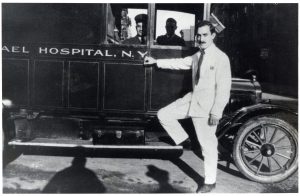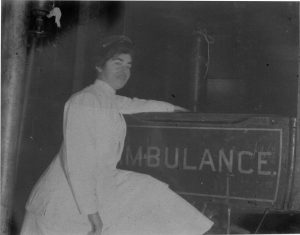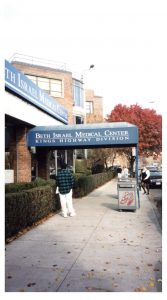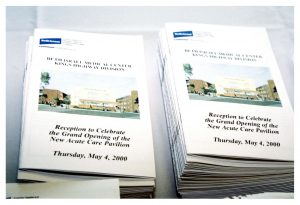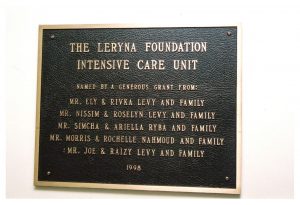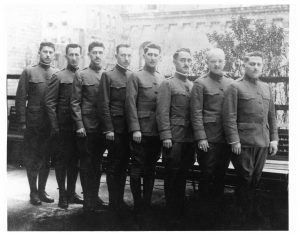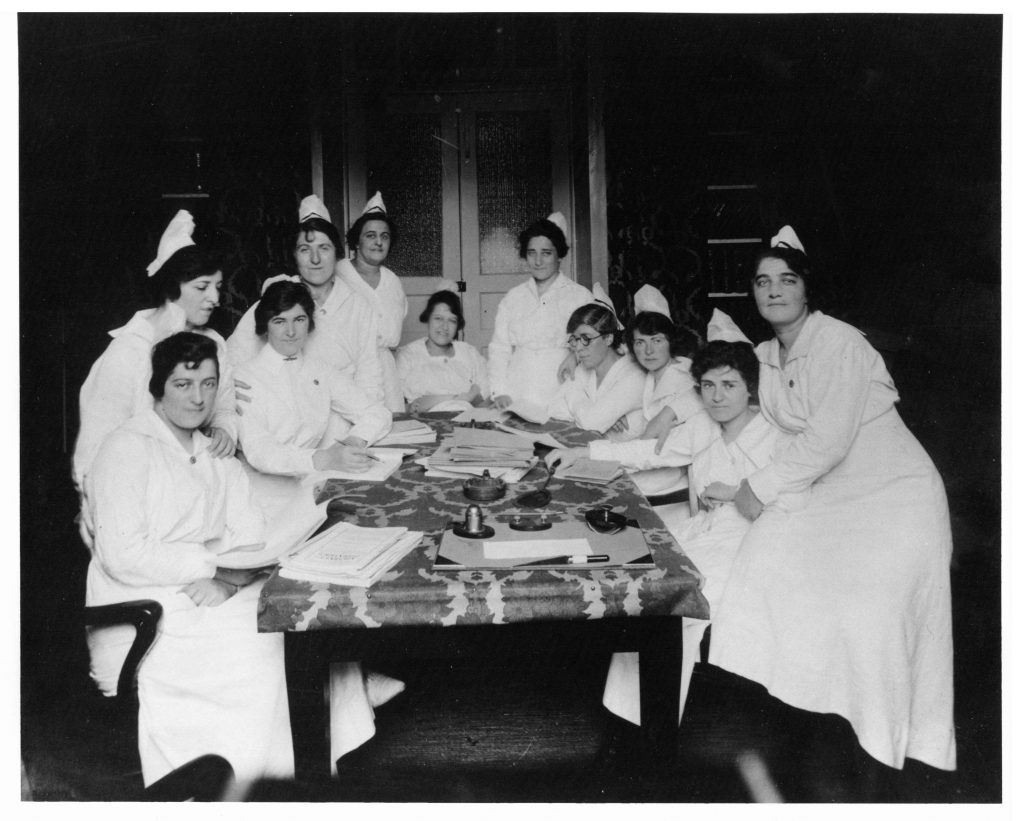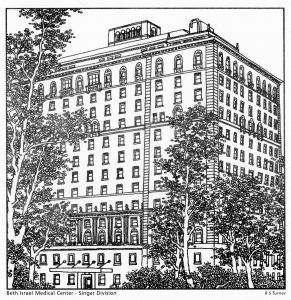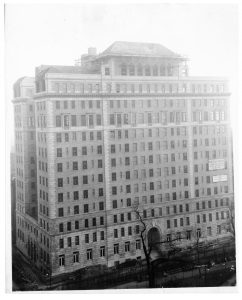May 16, 2022
A history of the ambulance service at Roosevelt Hospital, today’s Mount Sinai West, is available here. See the Building Beth Israel series for more information about the history of Mount Sinai Beth Israel. An interactive map of Beth Israel historical locations is available here.
National EMS Week is May 15-21. In this blog post, we’re celebrating by looking back at a brief history of emergency medical services at Mount Sinai Beth Israel.
The first ambulance service began at Beth Israel Hospital in 1906. It first used a horse-drawn carriage, later switching to automobiles in 1915. During this early period, ambulances were manned by members of the house staff, including Nettie Shapiro, MD, the first female house staff at MSBI in 1909.
By 1984, Beth Israel was “the first voluntary hospital in New York City to have attending physicians fully trained in emergency service on duty around the clock, every day of the week.” New York City did not mandate such 24-hour care in EMS participant hospitals until June 1, 1987.
In 1990, the Division of Emergency Medical Services was named for David B. Kriser, a Beth Israel trustee, in honor of a $3 million bequest from him. This led to a major renovation, and the division doubled in size.
Sources:
Authored by Stefana Breitwieser with research credit to Nicholas Webb
Mar 16, 2022
An interactive map of Beth Israel historical locations is available here. See the Building Beth Israel series for more information about the history of MSBI.
Mount Sinai Brooklyn is one of the more recent New York hospitals to join the Mount Sinai Health System. Prior to its most recent incarnation, the hospital dates to the 1950s and was a long-time division of Mount Sinai Beth Israel.
Prior to the 1950s, the location was a series of interlocking lots. In 1953, the parcel was created at 3201 Kings Highway for Samuel Berson, MD, a specialist in allergy and immunology, to create a nursing home there. Though the exact timing is unknown, the nursing home was converted into Kings Highway Hospital shortly after with 212 beds. In 1980, King’s Highway Hospital opened its North wing, without an increase in the number of beds. As a small, private, community hospital, not much documentation has survived from those years.
On July 11, 1994, a special meeting of the Beth Israel Medical Center Board of Trustees passed a resolution “that the Medical Center proceed to negotiate the acquisition of Kings Highway Hospital.” By adding Kings Highway to the existing Petrie and North divisions, “on the basis of total admissions per year, the acquisition makes Beth Israel the largest voluntary hospital in New York City and one of the largest in the United States.”
The period following Beth Israel’s acquisition marked a time of rapid renovation and development at the Kings Highway Division. This included renovations at the Surgi-Center (1996); the introduction of three-bed inpatient Acute Dialysis Unit (November 1996); an expansion of the Russian Health Service and other Russian language amenities (1998); and an expansion of the emergency room from six to seventeen treatment slots (Summer 1998). Perhaps most significant was the groundbreaking for the new building starting in May 1998, which included underground parking, a new emergency department, ICU, and five new operating rooms. The new facility, called the Acute Care Pavilion, was built on what was previously the hospital parking lot, and opened in May 2000.
These renovations and expansions continued with significant investment from donors. In February 1997, Beth Israel Kings Highway Division in Brooklyn received a $150,000 gift from the Leryna Foundation, the family foundation of Ely Levy, an electronics distributor and leader of the Sephardic community in Brooklyn. The gift doubled the number of beds in the ICU from six to twelve. In 1997, the Greater Montreal Convention and Tourism Bureau named Kings Highway Hospital as the beneficiary of proceeds for its production of Robert Lepage’s The Seven Streams of the River Ota at the Next Wave Festival of the Brooklyn Academy of Music. And finally, in December 2002, the Louis Mintz Family Waiting Room in Critical Care Unit was endowed.
With Beth Israel’s merger into the Mount Sinai Health System, the Kings Highway Division was renamed Mount Sinai Beth Israel Brooklyn in January 2014, and then was shortened to Mount Sinai Brooklyn in May 2015. It remains part of the Mount Sinai Health System today.
Sources:
Authored by Stefana Breitwieser with research credit to Nicholas Webb
Jan 10, 2022
In a previous blog post, we looked at Beth Israel Hospital’s role in the 1918 Influenza Epidemic. Since then, we’ve done further research into the World War I correspondence in the Beth Israel records, as well as the Beth Israel Board of Directors and Committee minutes, which both provided rich details to supplement this history.
In early March 1918, influenza had reached New York. By March 25, 1918, an unknown correspondent (likely Louis J. Frank, Beth Israel Hospital superintendent) wrote that there was “quite an epidemic in the City of Grippe,” referring to New York City as literally the “City of the Flu”. As World War I continued on, many Beth Israel workers had joined the war effort, and their correspondence with the hospital describes the epidemic on the front lines. The first wave of the flu was relatively mild, and on May 13, 1918, Dr. Alfred A. Schwartz of the American Expeditionary Force, reported as much from France:
“I have been appointed Otolaryngologist to the contagious disease wards at the camp hospital and altho [sic] the title sounds like work, there must first be complications to the infectious diseases, and secondly…there must be some patients to have the diseases, and fortunately there is little to do.”
As the second, more deadly wave swept the world, the topic of influenza became more pressing in the correspondence, and was increasingly addressed in the Board minutes. In the November 17, 1918, minutes, the Board noted that back on the home front in New York, Beth Israel attended to “50 to 60 cases of Influenza a day during the height of the epidemic and…our records of cures was high, and our record of deaths was very low.” This is a significant deviation from the previous blog post, which stated that only twenty-nine patients total were treated during the epidemic at Beth Israel. Sources conflict on this point.
Staffing was amongst the most pressing issues at this time – with much of the medical staff overseas, Louis J. Frank, himself recovering from the flu, commented in a letter from October 23, 1918: “Our whole force is gone. If you were to come back today, you wouldn’t find a familiar face…From a house staff of 15 we have been reduced to a staff of five, and of the five, three have been laid up on account of influenza.” He goes on to describe the issue of hiring enough nurses, which was making him “frantic.” Superintendent Frank was a proponent of the conscription of women, “especially those women who have the vote,” to counteract staffing shortages in nursing in the war and at home.
The Board of Directors’ minutes reflect similar staffing concerns. The minutes for November 17, 1918, stated: “During the epidemic the Surgical Staff consisted of one man, the others became infected with the disease. On the Medical side we only had two men, the others also sick.” This appears to have resulted in redeployment of other clinical workers, and the Board resolved on “the discontinuance of the work of the Polio Department on account of the epidemic of Influenza and Pneumonia to release the doctors and nurses connected with the clinic for the more important work.” The minutes also noted that the “pupil nurses” from Beth Israel Training School for Nurses (today’s Phillips School of Nursing at MSBI) “after their day’s work was over, did extra work in the district on these cases, spending an hour or two on emergency cases requiring special care.”
The close of 1918 marked a turning point. With the War over, and a dwindling number of cases following the peak of the second wave, the end was in sight. In a letter from November 27, 1918, Superintendent Frank wrote:
“Things are getting into shape at the Hospital. We were considerably upset on account of the War, shortage of help, doctors, nurses, the Influenza epidemic, and the general anxiety, but with victory came a relaxation and we are now awaiting the homecoming of you men who have done so much to achieve this victory.”
The Board also noted, grimly, on November 17, 1918, that Beth Israel was “the only Hospital [in New York City] that didn’t lose a nurse, a doctor, or an employee by death.” On January 19, 1919, the Board moved to give House Staff and pupil nurses bonuses for their contributions and made especial note of the nurses’ service: “pupil nurses…after their trying [work and school] day of 12 and many times 14 hours, went out in the tenement houses and did extra work for several hours. Of course, this work was not for patients of the Hospital, but it was nevertheless our work, for they were the poor sick of our neighborhood.”
On November 23, 1919, the Board made note of the U.S. Public Health Service’s prediction that the influenza epidemic would return. Fortunately, this never came to pass. By 1920, the virus mutated to cause only ordinary cases of the seasonal flu, and the epidemic was effectively over.
Sources:
More resources on Mount Sinai Health System Hospitals and World War I are available here.
Authored by Stefana Breitwieser, Digital Archivist
Nov 23, 2021
For more information about former Beth Israel locations, see the Building Beth Israel series. An interactive map of Beth Israel historical locations is available here. See all our holdings related to the Jewish Maternity Hospital, Doctors Hospital, and the Singer Division.
Mount Sinai Beth Israel has affiliated with several hospitals over its 130-year history. Though their names may have disappeared over time, their impact on the hospital’s history remains. This blog post looks at two Beth Israel affiliates, Jewish Maternity Hospital and Doctors Hospital, and their lasting influence on Beth Israel.
Jewish Maternity Hospital
The Jewish Maternity Hospital (JMH) first opened in February 1909 at 270 East Broadway with two consulting physicians, twelve house staff, and fifteen obstetrical nurses. By 1927, JMH accumulated a large building fund and wanted to expand its premises. The Jewish Federation of Philanthropies, which helped to fund many of the local Jewish hospitals during this period, preferred that it become part of a larger hospital rather than be maintained as a separate institution.
As another hospital funded by the Federation, not to mention a close neighbor on the Lower East Side, Beth Israel was a natural candidate – however, the proposed merger was not without controversy. At a 1928 meeting of the Board of Trustees, Beth Israel Superintendent Louis J. Frank firmly rejected it as an unwarranted drain on the space and resources and recommended that a separate building on the Beth Israel campus be constructed so that JMH did not take over beds in the newly built Dazian Pavillion. He also suggested that JMH consider affiliating with The Mount Sinai Hospital instead. (Prior to the Federation’s merger proposal, JMH had planned to construct a new building on 108th Street.) Board President Cohen, however, noted that control of the Maternity Hospital’s $700,000 building fund would enable Beth Israel to solve the financial difficulties caused by cost overruns for the construction of Dazian.
Later that year, a compromise was reached. The Federation proposed that Beth Israel absorb the JMH, that the boards of the two institutions merge (with a subcommittee for the newly formed maternity department consisting of the former JMH trustees), and that Beth Israel allocate beds in the new building specifically for obstetrical purposes. A motion was approved to accept the proposal, albeit reluctantly, with the Board noting that it “did not invite the merger, nor does it feel that there is any need or emergency, as far as Beth Israel Hospital is concerned… since provision has already been made in the new building for an adequate, efficient and up to date Maternity Service.”
The merger was announced in 1929 and finally occurred in 1930. Plans to construct a new building for the hospital adjacent to the Beth Israel campus in Stuyvesant Square were announced in 1931, though this building was never completed. Over the next decade, obstetrical services slowly transitioned to the Beth Israel campus, and in 1946, the JMH name disappeared. In 1948, the Obstetrics service notes, “the long-awaited physical consolidation of all labor and delivery rooms is effected.”
Doctors Hospital
Construction for Doctors Hospital began in 1929, amid a debate in the larger medical world about the necessity of private rooms versus the larger, shared wards common to the nineteenth century. When it opened in 1930, Doctors Hospital was described as “homelike,” “a model hospital with the atmosphere of a modern hotel” with “soft tinted walls, guest rooms and a private icebox…for every patient.” With its unusually well-equipped private rooms, and its location at 70 East End Avenue overlooking Carl Schurz Park and Gracie Mansion, Doctors Hospital secured its reputation as being a luxe medical facility for the famous and well-to-do for the rest of the century.
On August 3, 1987, it was announced that Doctors Hospital had been acquired by Beth Israel Medical Center and was renamed Beth Israel North. The name changed again in 1998 to the Beth Israel Medical Center Singer Division. In these years, the Hospital had a few notable developments. In 1988, it acquired a device for treating gallstones and bile duct stones, called a biliary lithotripter. It was the first in New York City, and Charles McSherry, MD, spearheaded the project. In 1990, the New York State Department of Health approved a certificate of need for the construction of twenty-four chronic dialysis stations at the hospital due to a lack of such facilities in Manhattan.
However, the Singer Division did not last. By 2004, it was formally closed, and the property was sold to developers. The facility was torn down the following year and was replaced with apartments.
Sources:
Authored by Stefana Breitwieser with research credit to Nicholas Webb
Nov 10, 2021
The Neustadter Home was created by a provision in the 1905 will of Caroline Neustadter to serve as a convalescent center for women patients after leaving the hospital. It opened in July 1919 on the northeast corner of Central Park Avenue and McLean Avenue in Yonkers, on land once owned by Boss Tweed, leader of Tammany Hall. In 1936, an agreement was reached between The Mount Sinai Hospital and the Neustadter Home whereby Mount Sinai could send patients to the facility. Three years later, men began to be admitted as well.

The original Neustadter Home in the 1950s
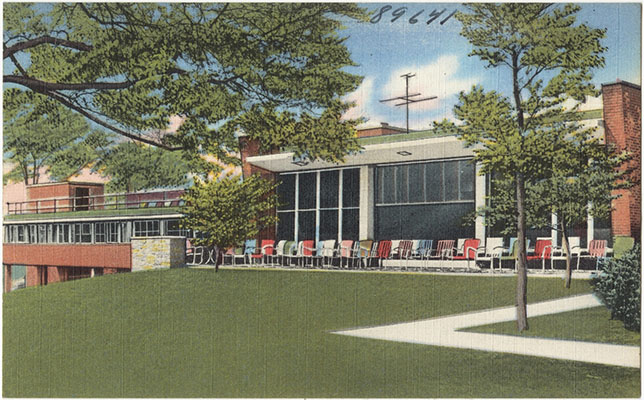
The Moses Weinman wing, opened in 1949
As hospitals saw the increasing value in freeing up beds for more acute cases by discharging patients to rehabilitation hospitals, Neustadter needed to expand. The Moses Weinman wing was added in 1949, bringing the institution up to 69 beds from the previous 56. The facility also enhanced its medical care services. To reflect this evolution, the name was changed from the Neustadter Home to the Neustadter Convalescent Center in 1954. Over the years, the patient population was composed primarily of post-surgical cases. As the 1971 Mount Sinai Annual Report on convalescent care said: “So often before we have described the true function of Neustadter as a bridge that spans illness to complete recovery.” In 1969, Mount Sinai was given preferential use of the Center and eventually the Neustadter Board members and the medical staff were affiliated with Mount Sinai.
The Convalescent Center did not have a bright future, however. In a 1959 study of Neustadter, only 24% of patients could afford the full weekly charge of $84. Money was a perennial problem. Also, because the Home was twelve miles from Mount Sinai Hospital, it was hard to provide follow-up care by physicians. In 1972, the Neustadter Board dissolved and transferred their assets to The Mount Sinai Hospital. The next year, Mount Sinai sought to sell the Convalescent Center. The sale for $1 million to a local Hebrew high school was announced in 1973, but the school struggled to make the payments. The matter sputtered along for a few years, and in 1980 the property was finally sold to a realty company. In 1983, a shopping center opened on the site, including a large Waldbaum’s grocery store. The shops remain; the Waldbaum’s is gone. The Neustadter Convalescent Center has also totally disappeared.
For information on what archival material the Aufses Archives has relating to the Neustadter Convalescent Center, click here.
Oct 12, 2021
See Building Beth Israel, Part 1: Foundations and Part 2: Jefferson and Cherry for the first parts of this series. An interactive map of Beth Israel historical locations is available here.
The final years at Beth Israel Hospital’s Jefferson and Cherry Streets location were marked by some of the most defining moments of the early twentieth century. While it’s not clear exactly when conversations in favor of a new hospital began, the Beth Israel Board of Directors began to purchase property on Livingston Place along Stuyvesant Square Park as early as 1915. (Livingston Place would later be renamed Nathan D. Perlman Place after the U.S. Congressman and Beth Israel Vice President.)
A primary motivation for the creation of what would become the Dazian Pavillion was likely related to hospital capacity – the thirteen-story building opened with nearly 500 private rooms and state-of-the-art facilities, a significant expansion over the 134 beds in wards at the Jefferson and Cherry Streets location. That said, justifications for the new building from the Board of Directors evolved from its earliest phases and its final construction in 1929. These reflect the many historical events of the era: modernization of health care, the introduction of the skyscraper, World War I and its aftermath, mass immigration, and the Influenza Epidemic of 1918.
The Tallest Hospital Building in the World
The Dazian Pavillion was conceived as a highly modern, state-of-the-art hospital building. At thirteen stories, it was the tallest hospital building in the world at that time. According to Islands of Compassion, Beth Israel “was the first to realize that a hospital skyscraper would mean freedom from the city’s noise and congestion.” This is evident in the discussions in the Board of Directors minutes. From March 16th, 1919:
It is of great concern to us to construct the new hospital according to the best methods of building; to provide the patients with as much comfort as possible, to serve them with palatable food, to provide them with fresh air and sunshine, to guard them from undue noise and excitement, and to keep the patient away from the smell and the workings of the Hospital – in a word, we are studying how best to care for the patient…The hospital of the future must be organized for prevention and not so much for cure.
World War I and its Aftermath
World War I was strongly felt at Beth Israel Hospital, with nearly half of the medical staff enlisted in the war effort. This continued throughout the war and beyond its end, and care for veterans presented itself as an early justification for a new hospital building. From the November 18, 1917 Board of Directors minutes:
The War presents the strongest argument for the construction of the new building. The War will last for some time and it is absolutely certain that there will be a great demand for hospital accommodation especially on account of the draft; deformities and disabilities are being discovered which require doctoring and good hospital care. The Beth Israel Hospital will be the only institution in the City to come up to expectations. We must be ready to receive cases on account of the epidemic that will surely follow the War and the new Hospital should stand as a permanent monument.
Beth Israel’s service to those affected by the war did not end with veterans. From the Board of Directors Minutes, October 17, 1920:
Congressman Siegel informed me that there are 200,000 Jews trying to secure passports for the United States. Orthodox Jews from Syria and Greece will come here in large numbers. That there are 15,000 Jews at Danzig awaiting transportation. If there is any doubt at all in the minds of anyone as to the necessity of a 500 bed Beth Israel Hospital for the treatment of Orthodox Jews this statement of Congressman Siegel should dispel them.
If Beth Israel was founded to care for Jewish immigrants in New York, the events following World War I only strengthened this resolve.
Influenza Pandemic of 1918
The Influenza Pandemic of 1918 was also a justification for the layout of the new building. The need for private rooms was a strong topic of debate in the years leading up to construction, within both the Board of Directors and the medical profession, considering hospitals largely operated out of shared wards at this time. The pandemic cemented the need for private rooms. From the Board of Directors Minutes, November 23, 1919:
…in respiratory infections…protection can only be obtained by safe-guarding one person from another, that the lesson derived from the severe experience of the recent Pneumonia epidemic is to the effect that such patients are not to be assembled into larged [sic] groups or kept in open wards but should be kept in separate rooms where they and their attendants may be preserved as far as possible from sputum droplet contamination.
The Dazian building would come to feature almost entirely private rooms.
Conclusion
Ultimately, the Dazian Pavillion took more than a decade to come to fruition. While many of the buildings and lots for the future space were purchased throughout the 1910s, there was significant slowdown in building progress due to the influenza epidemic. Building materials were also more expensive due to World War I.
On November 5, 1922 the cornerstone was laid. The ground was broken by Isaac Phillips, and future President Herbert Hoover, then U.S. Secretary of Commerce, were in attendance. The architect for the Dazian building was Louis Allen Abramson.
The building was finally opened in 1929. The Beth Israel Hospital School of Nursing (today the Phillips School of Nursing at Mount Sinai Beth Israel) moved into the 6th and 9th floors. Nearly 100 years after construction began, Dazian continues to be the home of Mount Sinai Beth Israel today.
Sources:
Authored by Stefana Breitwieser, Digital Archivist
